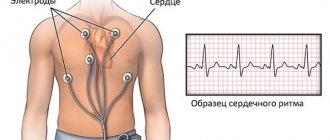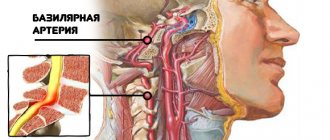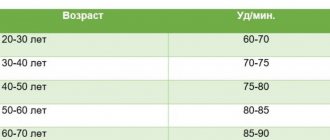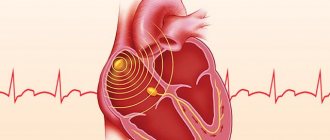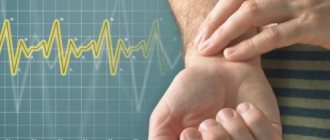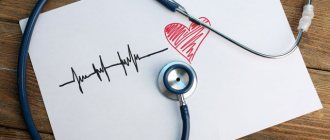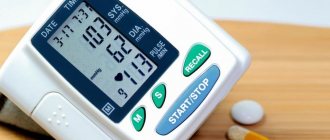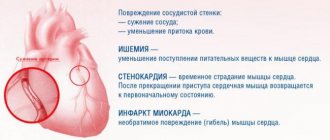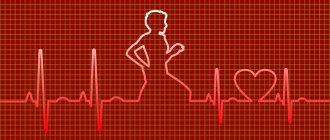Norm
First, let's define what a heart rate of 125 beats per minute means. For adults, doctors consider sixty to ninety beats per minute to be a normal value, but for children it is higher. The exact figure depends on the age category. A person’s lifestyle and environment seriously affect their heart rate. For example, in the evening it will always be higher than in the morning after waking up. During physical activity or anxiety, the value also increases.
What is cardiac tachycardia?
A healthy heart works in a constant rhythm, and normally a person does not feel its beating.
But if the normal heartbeat is disrupted, discomfort in the chest, anxiety, dizziness and pulsation in the area of large vessels appear. During the cardiac cycle, i.e. rhythmic contraction and relaxation of the heart muscle, the vessels are first filled with blood, and then their blood supply decreases. The vibration of the vascular walls during this cycle is called the pulse. Normally, the heart beats 60-90 times per minute. If the heart rate is more than 90 beats per minute, it is tachycardia, less than 60 is bradycardia.
How to measure pulse?
It is recommended to measure your pulse in the morning immediately after waking up in a lying position. It is better to do this on the wrist, feeling the artery with the middle and index fingers. You need to count the number of hits in 15 seconds and multiply the indicator by 4.
The heart rate in healthy people depends on many factors:
- gender: on average, women's heart beats slightly faster than men's;
- age: with age, the pulse gradually slows down, but after 50-55 years it increases again, especially in women with the onset of menopause;
- environment: poor environmental conditions affect heart rate;
- time of day: during night sleep the pulse slows down, and at 11 o’clock in the day it accelerates to maximum values;
- lifestyle: tachycardia is observed in people who smoke, as well as in people who regularly drink alcohol, with improper work and rest schedules, and lack of sleep;
- Diet: Some foods and drinks, as well as medications, speed up your heart rate.
An increase in heart rate can be observed in a completely healthy person after active sports, heavy physical work, with a lack of oxygen, heat, during stressful situations, after drinking a large amount of strong coffee or alcohol (Fig. 1). The heart beats faster in response to external factors. In this case, tachycardia is a reaction to the release of adrenaline into the blood or nervous excitement. Usually the pulse returns to normal after a fairly short rest.
Figure 1. How coffee and alcohol affect heart rate. Source: MedPortal
Another manifestation of the protective function of tachycardia is a rapid pulse in patients with internal bleeding or significant blood loss due to injury. An increase in heart rate allows you to avoid hypoxia and saturate the myocardium with oxygen in conditions of decreased hemoglobin levels in the blood.
Children's pulse
In children, the heart rate is noticeably different, since the growing body has a high need for oxygen and nutrients. An accelerated metabolism leads to an increased heart rate at rest. In newborns, the heart beats at a frequency of 120-140 beats per minute, the most frequent pulse in six-month-old babies is 130-135. With age, the heart rate gradually slows down, and in 15-year-old teenagers it is already approaching the norm for adults.
Provoking factors
A high pulse does not always indicate pathology. Some factors that provoke it are only temporary. We are talking about sudden stressful situations, fear, and taking medications.
Excessive consumption of alcoholic beverages, for example, during a celebration, as well as overeating and high emotional stress can also provoke this pathology. Doctors note that during the holidays and immediately after them, there is an increased number of patients seeking medical help due to heart problems.
Prevention of tachycordia
If tachycardia regularly makes itself felt, you should resort to a number of manipulations to stop the attack. In some cases, it will be necessary to provide primary medical care to the patient to stabilize the heart.
If an increase in heart rate occurs during physiological tachycardia, it is possible, by taking certain preventive measures, to stop the attack and thereby alleviate the patient’s condition.
Doctors recommend lying down for a while and trying to relax. The heart will calm down and the signs of tachycardia will disappear.
If this doesn't help, you should try this exercise:
- Inhale, tense your muscles, hold your breath, exhale and relax.
- Repeat several times until your heart calms down.
The purpose of the exercise is to activate the parasympathetic system. Its main carrier is the vagus nerve. By straining it, we stabilize the pulse.
Massaging the carotid artery helps a patient stop an incipient attack of tachycardia. It is necessary to apply light pressure with your fingertips on the neck area under the lower jaw. If you inadvertently put more pressure on the artery, you may faint.
Cold water will also help prevent an attack of tachycardia. You need to put it in a basin and immerse your face in water for one minute. Cold will help relax the heart and stabilize its functioning.
Other reasons
Why else can people experience heart rates as high as 125 beats per minute? This pathology is caused by anemia, dehydration, toxicosis of pregnant women, consumption of fatty foods, pathologies of the heart and blood vessels, strict diets, etc. If these causes are eliminated, the heartbeat usually returns to normal without special therapy.
Often people have a high pulse combined with low blood pressure. Even doctors do not always know what to do in such a situation, since almost all drugs that normalize the pulse also reduce blood pressure.
The patient should keep a diary and regularly record the measurement results in it. Based on these data, it is easier for the doctor to select the necessary treatment regimen that will help bring both indicators back to normal. It is important to find out what to do with a pulse of 125 beats per minute before a critical situation arises.
Folk remedies
Traditional medicine will tell you what to take when your heart rate is elevated to normalize your readings.
The following plant substances are recognized as the best stabilizers of the heart, blood vessels, and blood pressure:
- Melissa;
- linden blossoms;
- chamomile flowers;
- stinging nettle;
- Birch buds;
- lavender blossoms;
- lemongrass;
- green parts of mistletoe;
- mistletoe.
Advice! Traditional medicine can be used in practice in parallel with basic drug treatment. The main thing is that the chosen means are approved by the attending cardiologist.
According to the standard recipe:
- take a couple of glasses of boiling water
- dissolve 2 tablespoons of any plant material in it
- after which the mixture boils in a water bath for about 10-15 minutes.
It is also important to ensure that the body receives the full amount of magnesium. It helps to reduce tissue permeability, as a result of which potassium cannot enter the blood in unlimited quantities.
It is recommended to eat more of:
- soy;
- nuts;
- legumes;
- bran;
- dark green vegetables;
- crayfish and shrimp;
- chocolate;
- cocoa.
Proper nutrition during tachycardia does not independently reduce the pulse, but creates conditions for the action of drugs and prevents an increase in rhythm.
Necessary:
- give up alcohol, coffee and caffeinated drinks, reduce cocoa and chocolate consumption;
- take food in fractional quantities, avoid overeating;
- drink enough water;
- exclude spicy and hot foods from the diet;
- Foods high in potassium and magnesium are beneficial: legumes, peaches, bananas, melon, nuts.
If the cause of a frequent rhythm is neurocirculatory dystonia, then non-drug methods are successfully used:
- baths: pine, with essential oils (geranium, sage, rose);
- relaxing massage;
- reflexology (acupuncture, acupressure);
- electrosleep.
Good effectiveness in slowing heart rate was noted for dosed physical activity. At a low level of training, walking, therapeutic and breathing exercises, and yoga are used.
Exercises should not cause discomfort.
Constantly high heart rate
A significant disruption of myocardial rhythm occupies a leading position in the structure of cardiac and vascular pathologies. Currently, there are many patients in the world whose heart rate is 125 beats per minute even at rest.
Despite the prevalence of this phenomenon, diagnosis and treatment still pose some difficulties for cardiologists. The fact is that tachycardia (a pulse value of more than ninety beats per minute) has ambiguous symptoms. In many cases, a heart rate of 120 or more is considered normal for some, but for other patients this value may be critical. In any case, a rapid pulse requires differentiated diagnostics.
Consequences of increased heart rate
A pulse of 130 beats or more - is this normal or is it still dangerous?
The doctor will definitely notify him of the consequences of this condition.
Prolonged tachycardia can lead to the development of complex diseases, such as:
- arrhythmic shock;
- stroke;
- cerebral ischemia;
- thromboembolism;
- cardiac asthma;
- violation of metabolic processes;
- decreased immunity;
- acute ventricular failure.
An accelerated heart rate of 130 beats indicates certain risks, such as heart overload.
Which will sooner or later lead to its wear. The condition is accompanied by insufficient blood circulation and oxygen starvation, which will cause other organs and the brain to suffer.
Pulse 125 beats per minute. What to do?
If the pulse increases, if this is accompanied by additional unusual symptoms or pain, you must immediately call an ambulance. While the doctor is driving, you need to calm down, lie down on the bed, and try to relax at least a little. There are several techniques that help reduce the frequency of such intense heart contraction:
- You need to do a light acupressure, carefully and with little effort pressing your fingers on the eyes.
- Find a hole in the transition area of the hand on the left hand, press on this place and hold it in a clamped state for some time.
- Perform breathing exercises, inhaling until the diaphragm opens completely, and as you exhale, strain and cough.
- Give a light neck massage and knead the muscles just below the back of the head. They also stroke the neck on the left and right at the same time.
First aid for increased heart rate
If your heart rate is very high, do not panic. You can try home remedies to relieve the condition before you start taking medications. You need to take a horizontal position, raise your legs so that they are above the level of your head and lie down for 10–15 minutes. In this case, it is recommended to open the windows to provide oxygen access, and then take a deep breath and cough as you exhale.
If the condition has not stabilized on its own, and your health is worsening, you should call a medical team, and before they arrive, perform a number of actions:
- drink tincture of peony, motherwort, valerian or dissolve a Validol tablet;
- With little effort, press your eyeballs with your eyes closed and hold this position for 20–30 seconds;
- induce vomiting; impact on the root of the tongue;
- Gently massage the sides of the neck, at the location of the carotid arteries.
You can take a 20 mg tablet of Anaprilin, but other drugs are not allowed to be used without the permission of doctors. If, as a result of an increase in heart rate, a person loses consciousness, he needs to be washed with cold water, unbuttoned his clothes to allow fresh air to enter, and brought to his senses with ammonia.
Green tea with milk
Green tea, mixed with warm milk, is good for reducing high heart rate. This remedy quickly normalizes blood pressure and heartbeat, and also restores rhythm. Tachycardia, which is caused by temporary causes, does not require treatment.
As soon as a person returns to a normal state (rests after a run, calms down after a conflict), the pulse returns to normal. In all other cases, specialist advice is required. For example, if tachycardia is provoked by medications, the doctor will prescribe an analogue without such side effects.
Treatment
Treatment is aimed at eliminating the causes of rapid heartbeat and is carried out comprehensively. First of all, factors that cause tachycardia are excluded: it is forbidden to drink strong coffee, tea, alcoholic beverages, eat chocolate, or smoke. It is recommended to normalize your emotional state and avoid excessive physical activity.
The complex of treatment of the underlying disease includes sedatives and additional drugs that normalize the functioning of the heart muscle.
Photo: v_l / freepik.com
If tachycardia is caused by structural changes in the heart or a disruption in the production of hormones and does not respond to drug treatment, the patient may be offered surgery: radiofrequency catheter ablation, installation of a pacemaker, removal of tumors if present. In any case, the treatment regimen is prescribed by a cardiologist after consultation with other specialists.
Important! Medicines that correct heart rhythm should not be taken without a doctor’s prescription; incorrect selection of therapy can only worsen the disease.
Is there a danger with a high heart rate?
If a person's pulse is 125, what does that mean? The danger of increased heart rate lies in the asymptomatic nature of this pathology. High values can only be noticed after a targeted health check or when measuring blood pressure, which not all people do. Only as tachycardia progresses do people notice the appearance of the first symptoms:
- The occurrence of weakness and fatigue.
- The appearance of rapid breathing.
- Dizziness, even to the point of fainting.
- The appearance of a feeling of heartbeat in the ears and throat.
When this pathology occurs, some patients complain of nausea, chills, and headache. If the pulse increases to critical values (for adults this is two hundred beats per minute or more), the heartbeat may be physically felt in the chest. Loss of consciousness is observed at a rate of two hundred and ten beats and above.
Some types of arrhythmia are characterized by a sudden increase in heart rate for no apparent reason and a rapid return to normal. For example, when atrial fibrillation is the provocateur of a rapid heartbeat (above one hundred beats per minute), such symptoms are included in the clinical picture of the pathology. If during such surges a person experiences pain with tingling in the chest, then this is a sign of a negative process in the heart, which will require urgent research.
A persistent high pulse combined with normal blood pressure is common in patients with tachycardia. But these values are not always related to each other. The absence of signs of hypertension is not an indicator of health, but only serves as a mask for serious symptoms associated with heart disease. Only an experienced cardiologist can determine the presence or absence of a problem.
If frequent episodes of increased heart rate are observed, accompanied by discomfort, dizziness and numbness of the extremities, a cardiovascular examination should be performed. If the cardiologist does not find any serious abnormalities, you should continue to find out the causes of the abnormal condition by contacting other specialists.
How to cope with an attack of tachycardia?
If tachycardia (and the consequences of this disorder) is not the result of a disorder of the heart, but is only a physiological reaction to certain factors and situations, you can strive to limit the circumstances favorable to its occurrence:
- Limiting activity. According to cardiologists, rest is the best way to normalize your heart rate.
- Activation of the parasympathetic system. The frequency and strength of heart contractions are regulated by the sympathetic and parasympathetic systems. The main carrier of parasympathetic stimuli is the vagus nerve. The dominance of the sympathetic nervous system is associated with the fast work of the heart, since this system is responsible for preparing the body for the fight-flight response to stress. Therefore, in the event of tachycardia development, it is necessary to increase the impact on the parasympathetic system - stimulation of the vagus nerve initiates chemical processes, the result of which is to facilitate the work of the heart. To do this, take a deep breath and release the air, strongly tensing your muscles.
- Carotid artery massage requires prior medical advice on how to perform the procedure, as too vigorous movements can lead to inhibition of blood flow to the brain and fainting. You should gently massage the carotid artery - the place that needs to be pressed is on the border of the neck, deep under the lower jaw.
- Wetting your face with cold water. In marine mammals, swimming in cold water causes the heart to automatically release its function. Simply immerse your face in a container of cold water for 1-2 seconds. Sometimes this procedure interrupts the onset of tachycardia.
- Healthy regular meals, less sweets. Excessive consumption of sweets causes the pancreas to produce more insulin and causes periodic hypoglycemia. This condition causes the adrenal glands to produce additional adrenaline, which triggers the release of glycogen from the liver. Adrenaline (the main hormone of the sympathetic nervous system) stimulates the heart to work quickly, and the body is introduced into a state of uncontrollable excitement and fear.
Herbs and diet for tachycardia
Calming herbs, due to their properties, facilitate the stabilization of heart contractions. The following herbs are recommended:
- lemon balm,
- linden flower,
- nettle,
- chamomile,
- lavender,
- birch,
- ginkgo japonica,
- lemongrass,
- mistletoe,
- arjuna.
In addition to using soothing herbs, monitoring the level of magnesium in the body is necessary. It protects cells and balances the action of calcium in myocardial cells - the penetration of calcium into the cells stimulates contraction, and magnesium is the main component of enzymes that inhibits the influx of calcium into cells. The recommended daily dose of magnesium for women is 280 mg, for men - 350 mg.
Sources of magnesium:
- soybean,
- nuts,
- green beans,
- bran and grains,
- vegetables with dark green leaves, such as spinach,
- crustaceans,
- chocolate and cocoa.
A good solution is to use magnesium supplements.
People with heart problems need to monitor potassium levels. This is another element that affects the excitability of the muscle fibers of the heart. Its deficiency can be caused by excess sodium in the body, mainly salt from food, or the use of diuretics and laxatives.
Drug and surgical treatment
There are many drugs that are effective in treating coronary heart disease or hypertension. For complex types of tachycardia, beta-blockers or antiarrhythmic drugs are most often used. But they are not always effective or their use is associated with serious side effects. If drug treatment is unable to help, surgical treatment methods are used: implantation of a defibrillator. This procedure is performed in situations where the patient has experienced severe attacks of tachyarrhythmia and if there is a possibility of their reoccurrence.
The main function of this device is to stop ventricular tachycardia, flutter or ventricular fibrillation using electrical impulses. The defibrillator constantly analyzes the heart rhythm. It intervenes when it is too fast or too slow (so it also functions as a pacemaker). If it detects an accelerated heartbeat, then it sends weak electrical impulses that prevent tachyarrhythmia. When this is found to be ineffective, it sends a single strong electrical pulse synchronized with the heart's rhythm. It is unpleasant for the patient. It may be perceived as a blow, and even chest pain, but, as a rule, this interrupts a dangerous arrhythmia, including ventricular fibrillation, and restores the correct rhythm.
A chronically persistent high pulse of 120-130 beats per minute may warrant a visit to the doctor. A healthy person wishing to restore their elevated heart rate to normal should try to avoid substances that stimulate the heart, such as coffee (or caffeine from other sources), energy drinks, etc. For nervous patients, it may be helpful to restore a normal resting heart rate. studying relaxation techniques, aromatherapy, music therapy.
(
2 ratings, average: 5.00 out of 5)
Life expectancy with rapid heart rate
Let's find out how long you can live with a constant heart rate of 120-125 beats per minute?
According to the observations of scientists, at a value above ninety beats per minute, the mortality rate increases slightly compared to patients who have a low heart rate. Experts have calculated that with an increase in the rate for every ten blows, the risk of death increases by an average of sixteen percent (ranges from 10% to 22%).
At the same time, for non-smoking men, the risk of death increases by fourteen percent, and for smoking men - by twenty. It is difficult to answer the question of how long you can live with a constant high heart rate, but the overall life expectancy in any case is noticeably reduced.
Resting heart rate is one of the most important parameters of cardiovascular health in humans. It was noted above that the normal level ranges from sixty to ninety beats per minute. It is worth noting that in the morning a pulse of 125 beats per minute is considered a particularly dangerous symptom. With such a pathology, a mandatory medical examination and elimination of the causes of this condition are required.
High pulse with normal blood pressure
Pulse is a very important indicator of the state of the cardiovascular system. If it is within normal limits, this indicates that our “motor” is working without any serious disturbances.
People's blood pressure ranges on average from 100 to 140 millimeters of mercury (systolic) and from 70 to 90 (diastolic). Throughout the day, the values may vary somewhat, which is associated with various external factors, as well as blood viscosity, elasticity of the vascular walls, their resistance, and the intensity of heart contraction. Often, when your heart rate increases, your blood pressure also increases. But sometimes there is a pulse of 125 with normal pressure. Why is this happening?
There is no need to worry if the heart rate increases more than ninety-five beats, and the pressure values are within the normal range. This happens against the background of physical and psychological overload. This is also a consequence of lack of sleep or a powerful emotional shock.
A similar picture is observed when carrying a child. In such situations, tachycardia is considered a temporary phenomenon. When the provoking factors go away, the heart rate returns to normal on its own. True, with normal pressure there are also pathological reasons for such acceleration. A pulse of 125 with low blood pressure is often observed in the following situations:
- Anaphylactic shock.
- Large blood loss.
- Intoxication, poisoning.
- Myocardial infarction.
- Cardiopsychoneurosis.
- Hormonal disorders.
With high blood pressure, the reasons for a rapid pulse may be:
- Oncological diseases.
- Anemia.
- Problems with the thyroid gland.
- Respiratory system disorders.
Why is tachycardia dangerous?
Tachycardia poses a health hazard if it is caused by dysfunction of the cardiovascular system or other diseases of the internal organs. A rapid heartbeat prevents the heart ventricles from filling with blood, which leads to a decrease in blood pressure and a deterioration in the blood supply to internal organs. In addition, a heart working hard requires much more oxygen. This condition threatens to develop into acute heart failure and lead to heart attack and coronary artery disease.
Causes of rapid heart rate with normal blood pressure
They are usually the following:
- Failure of the optimal rest regime for the body.
- The presence of pneumonia, bronchial asthma, bronchitis, occurring in an acute form.
- Obesity.
- The influence of hormonal imbalance and iron deficiency anemia, as well as anemia.
- The presence of acute viral diseases.
- The appearance of infectious pathologies with complications in the heart.
- Development of spinal osteochondrosis.
- Consequence of bad habits.
- The presence of abnormalities of the vascular system.
- Long-term use of potent medications.
- The development of vitamin deficiency and chronic kidney or liver diseases.
- VSD, as well as thromboembolism.
Clinical picture of tachycordia
In order to promptly diagnose an attack of tachycardia, it is important to know the first and characteristic signs of this condition.
They are the following manifestations:
- darkness in the eyes;
- dizziness;
- dyspnea;
- prostration;
- lightheadedness or fainting.
